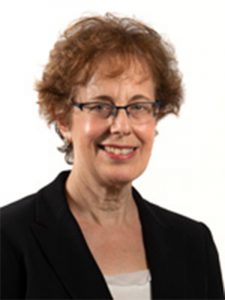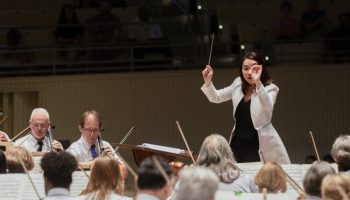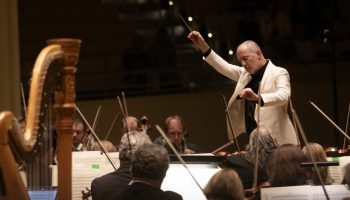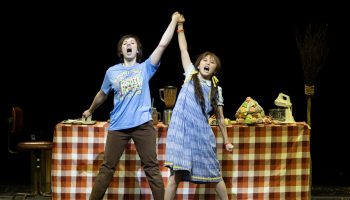The old phrase goes, “If you love what you do, you’ll never have to work a day in your life.” If that’s the case, violinist Diane Bruce said, history’s most celebrated composers never worked a day in their life — but they still needed to make a living. It just so happens that for these musicians, their livelihoods and passions seamlessly intersected.

For Week Seven’s Into the Music with the Chautauqua Symphony Orchestra, CSO principal second violinist Bruce, cellist Peter Anderegg, and two frequent CSO substitutes violist Carrie Fischer and violinist Leslie Anderegg, will perform string quartets by Haydn, Saint-Georges, Beethoven, Ravel and Joplin, all while exploring how the composers marketed their works and made income from their compositions.
The quartet will perform “Where’d They Get that Paper? Classical Composers and Music Marketing Since the 1700s” at 8:15 p.m. EDT Tuesday, Aug. 11, on the CHQ Assembly Virtual Porch.
Peter Anderegg, who compiled the research behind the program’s theme, will present his findings throughout the performance. With selections across centuries and styles, Bruce said it was difficult to keep the details concise.
“What we are able to fit in is very telling about their lives both inside and outside of music,” Bruce said. “Most often, people do introductions about the music itself, so discussing the impact the music had on (composers’) careers and livelihood is something completely different.”
The set consists of single movements from seven different pieces. Although this is an “unusual choice” in the 21st century, Bruce said “picking and choosing” wasn’t uncommon when the composers of the night called the shots.
“These composers frequently played selections rather than complete works,” she said. “So, in keeping with the practice that would have occurred in Hadyn and Beethoven’s lives, we chose pieces that would’ve been performed in single movements in a salon setting, such as a living room in a palace for a more noble audience.”
The set begins with Joseph Boulogne’s String Quartet in G minor, Op. 1, No. 3. Boulogne, also known as Chevalier de Saint-Georges, was a classical composer, conductor and virtuoso violinist.
Next on the program is Joseph Haydn’s String Quartet in E-flat, Op. 33, No. 2, “The Joke” and String Quartet in C Major, Op. 76, No. 3, “Emperor.”
“The two Hadyn movements we chose completely contrast one another,” Bruce said. “We wanted to prove there is still a sense of versatility to be found even when the names repeat. That’s part of why they were successful financially — some of them could do it all.”
Following Hadyn is Beethoven, more specifically the first movement of Beethoven’s String Quartet in F Major, Op. 18 and the third movement of his String Quartet in C Major, Op. 59.
Beethoven’s Opus 18 was only the second string quartet he ever composed. Bruce said it displays both the strengths and weaknesses of “early Beethoven.”
“Weaved in this early piece is the style of Mozart, but it still distinctly sounds of Beethoven in its dramatic contrasts,” Bruce said. “His Opus 59, on the other hand, has a completely different texture and quality to the style. He couldn’t seem to choose at the time.”
Next is the first movement Maurice Ravel’s String Quartet in F Major, a quartet that is considered to be Ravel’s first “major success as a composer,” according to Bruce.
“Ravel was one of the main composers who developed the style of impressionism,” she said. “He was very prolific, though he only wrote this one string quartet piece, which is very evocative and extremely beautiful. It’s a completely different flavor from the Hadyn and Beethoven.”
The last piece is Scott Joplin’s “Maple Leaf Rag,” an early ragtime musical composition initially orchestrated for piano. It was one of Joplin’s early works, and became the model for ragtime compositions by subsequent composers. He was eventually dubbed the “King of Ragtime” by his contemporaries.
As soon as someone from the audience starts speaking to you, you see them as just people,” Bruce said. “You hear their voice, you see their mannerisms, you hear what uniquely stood out to them. Now, even though we have lost the physical aspects, there is still a chance to make music that personal. It’s surprising how powerful these efforts have turned out to be.”
For the past two weeks, the quartet has been able to rehearse and record together on the grounds. Bruce said the opportunity to engage in “any kind of live music” during the COVID-19 pandemic has been “satisfying to the soul.”
“Beyond that, it’s always satisfying to play quartet music and to be a part of a smaller configuration, especially for those of us who play a bulk of our work as a part of a symphonic sound,” she said.
Following the music is a live Q-and-A hosted by Vice President of Performing and Visual Arts Deborah Sunya Moore. Bruce said the opportunity to virtually engage with the audience is reminiscent of her favorite part of the physical experience: forming connections.
“As soon as someone from the audience starts speaking to you, you see them as just people,” Bruce said. “You hear their voice, you see their mannerisms, you hear what uniquely stood out to them. Now, even though we have lost the physical aspects, there is still a chance to make music that personal. It’s surprising how powerful these efforts have turned out to be.”




